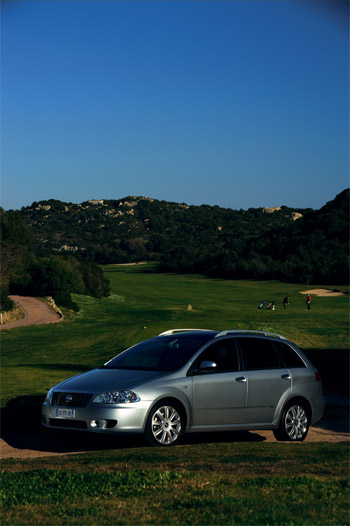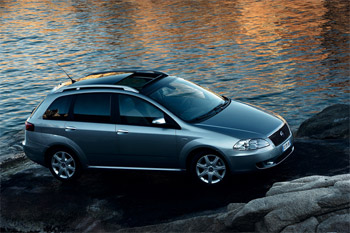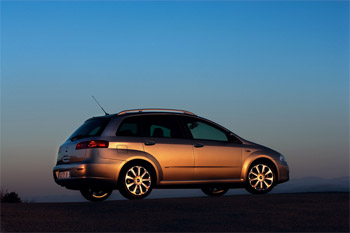|
STYLING AND ORIGINALITY
|
|
The originality of the new Croma is summed up by its elegant, distinctive styling, made all the more captivating by smooth, simple clean lines, which make the roomiest car in its segment look dynamic and harmonious. The work of Giorgetto Giugiaro, the Croma communicates a new approach to the car, even in stylistic terms. It is designed to meet the needs of European society, where "new families" with small children are starting to pay more attention to substance and to demand safety and reliability from their cars: everything at an accessible price.
The car is proposed with one type of body, and it transmits a sense of solidity, sturdiness and roominess. This impression is confirmed by the measurements: it is 475 cm long, 177 cm wide and 160 cm high, with a wheelbase of 270 cm, and the result is an extraordinary amount of roominess on board. Very briefly, the new Croma is in line with the competition where length and width are concerned, and about 10 centimetres higher, while it is well above the average for this segment in terms of interior dimensions.
A distinctive design by Giorgetto Giugiaro
Disregarding existing types of cars, the Fiat Croma proposes the new formula of the "Comfort Wagon": it is not a people-mover because it has the imposing, penetrating front of a luxury saloon (Cd of 0.28); it is not an SUV or an MPV because it is not as tall, and has significant overhangs so as not to compromise the elegant balance of the volumes; and finally, it is not a conventional station wagon because it is not the result of the extension of a 3-box body and it does not terminate with a vertical tail.
The new model represents an innovative type of extremely comfortable saloon, a new formula that is born from the position of the second row of seats, which are at an optimal height with respect to the ground, allowing passengers comfortable access; they do not have to climb up or down, but simply move over horizontally, helped by the fact that the sill is lower, almost level with the floor at that point, providing plenty of foot room between the seat and the door pillar. What is more, the greatest coefficient of roominess was given to the driver and the front passenger, who have plenty of room in all directions, with micrometric adjustment of the seat/steering wheel ratio and perfect visibility, all but eliminating any blind spots.
Comfort is therefore the most striking element of the new model, as Giorgetto Giugiaro explained: "When we studied the car in the early days of the project, we started with the coefficients for the passengers and I drew on the experience gained with the Maserati Buran research prototype, which I had conceived in 2000 as a compact, luxury limousine with a sliding second door. In fact I used the same roominess and access coefficients. I remember presenting the Buran to Giovanni Agnelli on the Lingotto test track, and he was very much in favour of the philosophy of offering as much space as possible for passengers to move about. Nor would I underestimate the aesthetic impact of the mew model: it is elegant and prestigious, a vehicle that confirms quality features that will certainly be appreciated on the market."
The large overhangs - the car is 261 mm longer than the previous model, having increased from 4495 to 4756 mm - has resulted in a drastic tapering of the front volume, and a penetrating aerodynamic profile. This is why the light clusters are positioned at an angle, while it is the large grille that gives the car its important, elegant status, accentuated by the way the grille trim is incorporated optically into the frame of the air intake under the bumper. A deep "V" that climbs from the grille to the windscreen pillars creates a central depression that animates and strengthens the bonnet. And the design of the bumpers breaks with tradition because it is not horizontal where they meet the sheet metal, but has a sinuous line that merges into the light clusters and grille. The foglights are located in the lower part, between the three air intakes.
From the side, the styling took into account the possible blind spot at the rear, and added a large quarterlight which makes the passenger compartment more panoramic, particularly on the version with the transparent sunroof. The attention that went into the aerodynamics almost meant that the bulges that protect the wheelarches are not semicircular, but dissolve into the headlights and the bonnet at the front, and into the lights and the boot lid at the rear. The sides have a slight break in the upper part, aligned with the door handles and there is a recess at the bottom, above the sill which protrudes to protect the doors. Like the front, the rear end is also of a generous size to accommodate the panoramic rear window and a wrapround boot lid that is easily opened with a handle; the luggage compartment itself is decidedly capacious. To give balance to the whole, the rear light clusters extend horizontally, partly on the boot and partly on the body; the break between the bumpers and the boot lid continues on the side. And finally, the registration plate is positioned in the bumper which is shaped to protect the corners of the car.
|
 |
|

 |
|
Created "for" and "around" man
The new Croma boasts an unbeatable amount of space inside and class-topping roominess. The lines that run inside the passenger compartment are harmonious, well balanced with those on the outside, and, together with the generous glazed area of 3.5 m2, they create a welcoming, luminous cabin, which provides plenty of room and a higher level of comfort than you would expect from a conventional Station Wagon in terms of ergonomics and space for the driver and passengers.
The term "comfort" applied to a car indicates a light, luminous environment which guarantees both excellent domination of the road for those in the front seats, and a perfect view for rear seat passengers. Total immersion in nature, which the new model guarantees unreservedly, in fact, amplifies this effect thanks to the large double sunroof. With this sunroof, the glazed area reaches an amazing 5 m2, or 75% of the entire surface area above the waistline. That is not all, the concept of "comfort" also means being seated with plenty of space all around in a comfortable, quiet environment.
So the Fiat Croma was created "for" and "around" man, welcoming and practical, a car in which to experience relaxing moments and comfortable journeys, enjoying a concrete, diffused sense of wellbeing on board. In order to achieve this goal, from the early stages of the development of the new model, the engineers adopted the latest ergonomic criteria to define the parameters that measure a car's ability to provide wellbeing and comfort on board. The end result is the excellent values achieved by the Fiat Croma for the basic ergonomic functions: roominess, driving posture, access, visibility and reconfigurable space. These have always been winning qualities and they are even more important today, when we spend more time in our cars.
There is a growing trend towards higher (and thus roomier) segments, and the average height of the population is increasing. This is why the new Croma offers a comfortable environment to people of all shapes and sizes. On the front seats, for example, the driver can raise or lower his seat and adjust the height and rake of the steering wheel to obtain an excellent roominess coefficient and an ideal driving position (catering for drivers from 1.50 metres to about 2 metres tall). And even if the driver is very tall, there is still plenty of room for an equally large passenger to sit comfortably behind him. The width at shoulder height on the front seats is 1,425 mm, and 1,400 mm at the rear (both values are the best in this category). The coefficient of roominess is one of the best in the segment at 97.6 percentile, a value that refers to both the front and the rear seats.
In line with the exterior styling, the new Croma proposes classical and extremely comfortable elements with updated dimensions that increase the luminosity, and allow airbags to be mounted. The materials used to upholster the facia and door panels comes in a choice of treatments, from shiny to opaque, depending on the specification. The front and rear door panels with their large armrests, controls and services are identical, which underlines the attention paid to passengers on the second row. The rear part of the passenger compartment offers outstanding comfort where both leg-room and squab position are concerned. There are numerous closed storage compartments and the front seat folds down into a table to carry large loads or to act as a work surface (standard on the top-of-the-range version).
Comfort is also assured by the numerous interior customisation alternatives: both seats are height-adjustable; the position of the steering wheel, (which adjusts for height and reach) and of the pedals, positioned centrally in front of the driver's seat; the gearshift on the facia where it is easier for any driver to manoeuvre; the instruments are practical, accurate and easy to read; the multifunction display provides access to various menus (with submenus) that speak the motorist's language and offer a host of functions plus a trip computer; a climate control system with dual-zone control of temperature and distribution makes a significant contribution to on-board well-being. Lastly, a radio with CD player (and an MP3 player as an option) offers an excellent sound system tailored to the vehicle and complete with six speakers.
And finally, the Fiat Croma has a capacious luggage compartment, which expands when the seats are folded down. It is already one of the largest in its category (500 litres), but when still more space is needed, the rear seat folds down completely to provide an extraordinary loading capacity of 1,610 litres up to the roof. There is also an optional modular shelf, level with the bottom of the rear panel, which covers the well of the luggage compartment to create a flat loading area.
The storage space beneath, which is 16 cm high and protected from prying eyes, can be used for various items (laptop, briefcase, etc.). And when the entire storage capacity is required, the shelf can be positioned on the bottom of the well, to exploit the loading capacity in full.
|
|